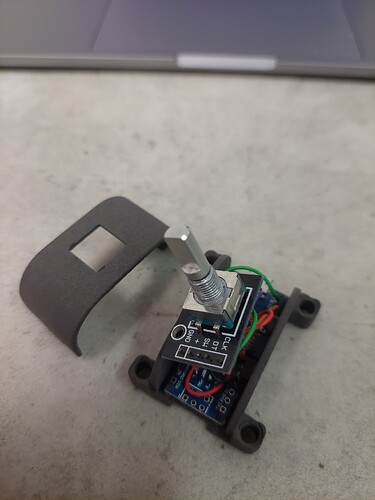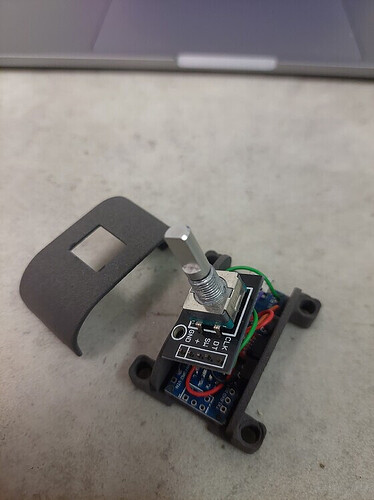Ich mache Encoder-Impulse auswerten nie "zu Fuß" sondern nehme eine library oder einen Timer-Interrupt dafür
interrupt-basierte library demo
#include "Arduino.h"
#include "NewEncoder.h"
const byte EncChA_Pin = 2;
const byte EncChB_Pin = 3;
const int minVal = -20;
const int maxVal = 20;
const int startVal = 0;
// Pins 2 and 3 should work for many processors, including Uno. See README for meaning of constructor arguments.
// Use FULL_PULSE for encoders that produce one complete quadrature pulse per detnet, such as: https://www.adafruit.com/product/377
// Use HALF_PULSE for endoders that produce one complete quadrature pulse for every two detents, such as: https://www.mouser.com/ProductDetail/alps/ec11e15244g1/?qs=YMSFtX0bdJDiV4LBO61anw==&countrycode=US¤cycode=USD
NewEncoder myEncoderObject(EncChA_Pin, EncChB_Pin, minVal, maxVal, startVal, FULL_PULSE);
int16_t currentValue;
int16_t prevEncoderValue;
void setup() {
// myEncState is a variable of type EncoderState
// EncoderState is a structured variable that has two "simple" variables
// .currentValue which is type int16_t
// (16 bit signed integer valuerange -36767 to 36767)
// currentValue counts up / down with each pulse created through rotating the encoder
// and
// .currentClick which is of type "EncoderClick"
// the variable type "EncoderClick" can have just 3 values
// NoClick, DownClick, UpClick where "click" means a "pulse" created through rotating the encoder
NewEncoder::EncoderState myEncState;
Serial.begin(115200);
delay(2000);
Serial.println("Starting");
if (!myEncoderObject.begin()) {
Serial.println("Encoder Failed to Start. Check pin assignments and available interrupts. Aborting.");
while (1) {
yield();
}
} else {
// store values of currentValue and EncoderClick into variable myEncState
myEncoderObject.getState(myEncState);
Serial.print("Encoder Successfully Started at value = ");
prevEncoderValue = myEncState.currentValue;
Serial.println(prevEncoderValue);
}
}
void loop() {
NewEncoder::EncoderState myCurrentEncoderState;
// store actual values into variable myCurrentEncoderState
if (myEncoderObject.getState(myCurrentEncoderState)) {
Serial.print("Encoder: ");
currentValue = myCurrentEncoderState.currentValue;
// if currentValue has REALLY changed print new currentValue
if (currentValue != prevEncoderValue) {
Serial.println(currentValue);
prevEncoderValue = currentValue;
// if currentValue stayed the same because the number is at upper/lower limit
// check if encoder was rotated by using the UpClick / DownClick-values
} else
switch (myCurrentEncoderState.currentClick) {
case NewEncoder::UpClick:
Serial.println("at upper limit.");
break;
case NewEncoder::DownClick:
Serial.println("at lower limit.");
break;
default:
break;
}
}
}
TimerInterrupt basierte library
/* Demo-Code that uses the Rotary-library from GitHub-User https://github.com/buxtronix
* using his library https://github.com/buxtronix/arduino/tree/master/libraries/Rotary
* in combination with a timer-interrupt executed 10000 times per second
* Copyright 2023 StefanL38. Licenced under the GNU GPL Version 3.
* A T T E N T I O N !
* this demo-code uses Timer1 which is used by other libraries too.
* This means using this code can interfere with other libraries
* causing malfunction of both
*
* This demo-code uses the TimerInterrupt.h-library from here
* https://github.com/khoih-prog/TimerInterrupt/tree/master
*
* The examples in the GiPo show how to use different timers
* The demo-code simply prints the value of variable myCounter
* each time the value of the variable changes
*/
#define USE_TIMER_1 true
#if ( defined(__AVR_ATmega644__) || defined(__AVR_ATmega644A__) || defined(__AVR_ATmega644P__) || defined(__AVR_ATmega644PA__) || \
defined(ARDUINO_AVR_UNO) || defined(ARDUINO_AVR_NANO) || defined(ARDUINO_AVR_MINI) || defined(ARDUINO_AVR_ETHERNET) || \
defined(ARDUINO_AVR_FIO) || defined(ARDUINO_AVR_BT) || defined(ARDUINO_AVR_LILYPAD) || defined(ARDUINO_AVR_PRO) || \
defined(ARDUINO_AVR_NG) || defined(ARDUINO_AVR_UNO_WIFI_DEV_ED) || defined(ARDUINO_AVR_DUEMILANOVE) || defined(ARDUINO_AVR_FEATHER328P) || \
defined(ARDUINO_AVR_METRO) || defined(ARDUINO_AVR_PROTRINKET5) || defined(ARDUINO_AVR_PROTRINKET3) || defined(ARDUINO_AVR_PROTRINKET5FTDI) || \
defined(ARDUINO_AVR_PROTRINKET3FTDI) )
#endif
// To be included only in main(), .ino with setup() to avoid `Multiple Definitions` Linker Error
#include "TimerInterrupt.h"
#define TIMER1_INTERVAL_MS 1
#include <Rotary.h>
// Rotary encoder is wired with the common to ground and the two
// outputs to pins 5 and 6.
const byte channel_A_Pin = 5;
const byte channel_B_Pin = 6;
Rotary rotary = Rotary(channel_A_Pin, channel_B_Pin);
unsigned long myISR_TimerFrequency = 10000;
// myCounter that will be incremented or decremented by rotation.
// as this variable is changed in an interrupt-service-routine
// this variable MUST !! be declared volatile to make sure
// that it works properly !
volatile int8_t myCounter = 0;
int8_t last_myCounter = 0;
void TimerHandler1() {
unsigned char result = rotary.process();
// depending on having detected rotation
if (result == DIR_CW) {
myCounter++;
}
else if (result == DIR_CCW) {
myCounter--;
}
}
void PrintFileNameDateTime() {
Serial.println( F("Code running comes from file ") );
Serial.println( F(__FILE__) );
Serial.print( F(" compiled ") );
Serial.print( F(__DATE__) );
Serial.print( F(" ") );
Serial.println( F(__TIME__) );
}
// easy to use helper-function for non-blocking timing
boolean TimePeriodIsOver (unsigned long &startOfPeriod, unsigned long TimePeriod) {
unsigned long currentMillis = millis();
if ( currentMillis - startOfPeriod >= TimePeriod ) {
// more time than TimePeriod has elapsed since last time if-condition was true
startOfPeriod = currentMillis; // a new period starts right here so set new starttime
return true;
}
else return false; // actual TimePeriod is NOT yet over
}
unsigned long MyTestTimer = 0; // Timer-variables MUST be of type unsigned long
const byte OnBoard_LED = 13;
void BlinkHeartBeatLED(int IO_Pin, int BlinkPeriod) {
static unsigned long MyBlinkTimer;
pinMode(IO_Pin, OUTPUT);
if ( TimePeriodIsOver(MyBlinkTimer, BlinkPeriod) ) {
digitalWrite(IO_Pin, !digitalRead(IO_Pin) );
}
}
void setup() {
Serial.begin(115200);
Serial.println("Setup-Start");
PrintFileNameDateTime();
Serial.print(F("\nStarting Argument_None on "));
Serial.println(BOARD_TYPE);
Serial.println(TIMER_INTERRUPT_VERSION);
Serial.print(F("CPU Frequency = "));
Serial.print(F_CPU / 1000000);
Serial.println(F(" MHz"));
// Timer0 is used for micros(), millis(), delay(), etc and can't be used
// Select Timer 1-2 for UNO, 1-5 for MEGA, 1,3,4 for 16u4/32u4
// Timer 2 is 8-bit timer, only for higher frequency
// Timer 4 of 16u4 and 32u4 is 8/10-bit timer, only for higher frequency
ITimer1.init();
// Using ATmega328 used in UNO => 16MHz CPU clock ,
// For 16-bit timer 1, 3, 4 and 5, set frequency from 0.2385 to some KHz
// For 8-bit timer 2 (prescaler up to 1024, set frequency from 61.5Hz to some KHz
if (ITimer1.attachInterruptInterval(TIMER1_INTERVAL_MS, TimerHandler1)) {
Serial.print(F("Starting ITimer1 OK, millis() = ")); Serial.println(millis());
}
else {
Serial.println(F("Can't set ITimer1. Select another freq. or timer"));
}
}
void loop() {
BlinkHeartBeatLED(OnBoard_LED, 250);
// check if value has changed
if (last_myCounter != myCounter) {
// only if value REALLY HAS changed
byte difference = abs(last_myCounter - myCounter);
if (difference != 1) {
Serial.println("difference != 1 counter jumped !!");
}
last_myCounter = myCounter; // update last_myCounter
Serial.print("myCounter=");
Serial.println(myCounter);
}
}
vgs




